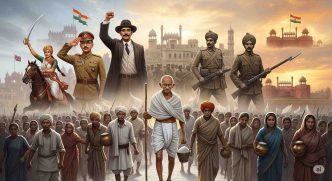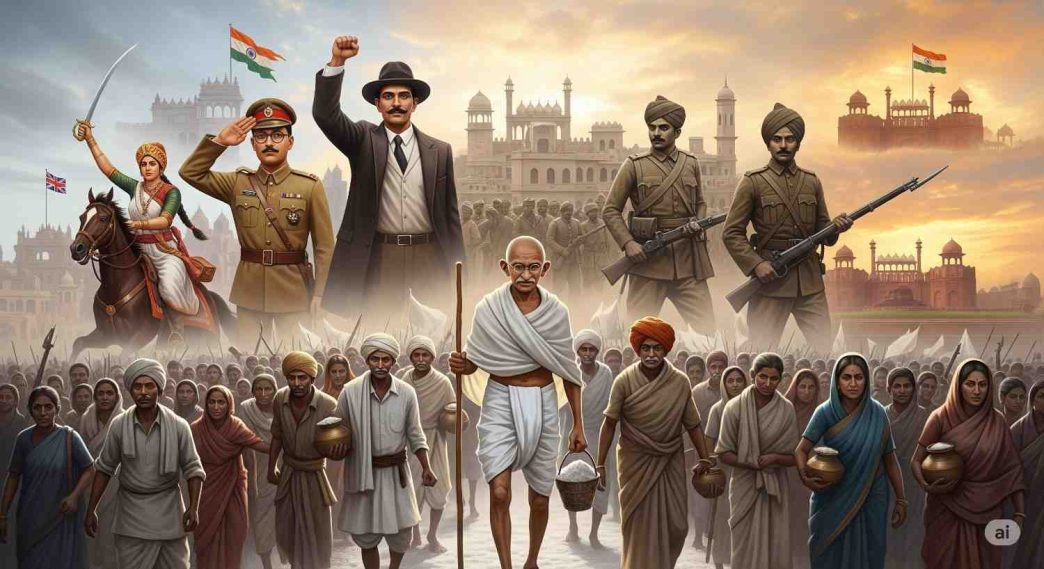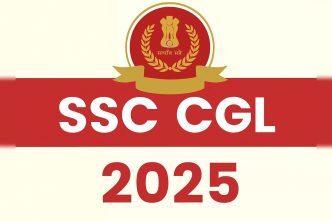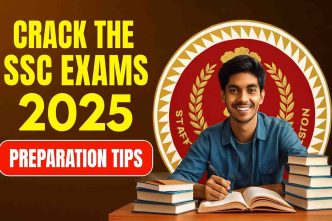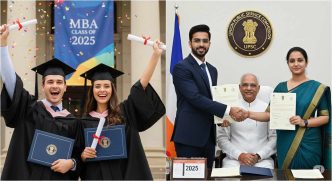Explore the Indian freedom struggle—200 years of courage, sacrifice, and resistance that led to India’s independence from British rule.
Introduction
The Indian freedom struggle was not merely a political movement—it was a monumental journey of resistance, unity, and unmatched sacrifice. Spanning nearly two centuries, India’s quest for independence is a story of ordinary people doing extraordinary things. From silent protests to fiery revolts, from non-violent resistance to armed rebellion, the spirit of freedom lived in every corner of the subcontinent. This article dives deep into the timeline, turning points, and unsung heroes of India’s relentless struggle against British colonial rule.
The Beginning of British Rule
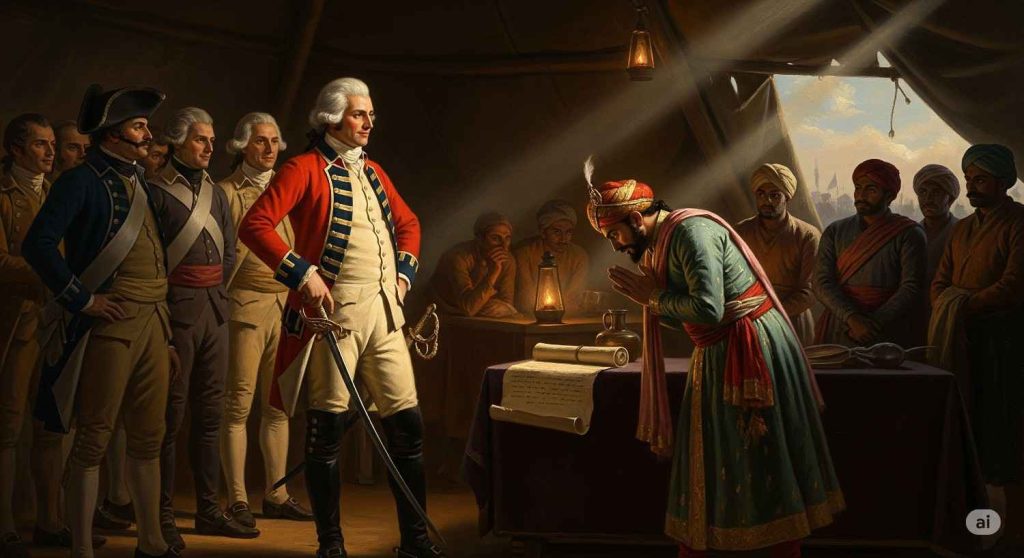
The roots of colonial dominance in India can be traced back to 1757, when the British East India Company defeated the Nawab of Bengal in the Battle of Plassey. What began as trade relations soon turned into political manipulation and military conquest. By the early 1800s, large parts of India had fallen under British control, and their policies drained India’s wealth while suppressing its people.
The Indian freedom struggle had begun—but it would take generations of resistance before the country would finally breathe free.
1857: The First War of Independence
Often called the Sepoy Mutiny or The Revolt of 1857, this was the first large-scale uprising against British rule. Soldiers in the British army—mostly Indian sepoys—revolted against their colonial masters, supported by local rulers and civilians.
While the revolt was eventually crushed, it marked a psychological turning point. It sowed the seeds of nationalism, and Indians began to see themselves as part of a larger cause. The spirit of rebellion was born, and it would never die again.
Birth of Political Movements
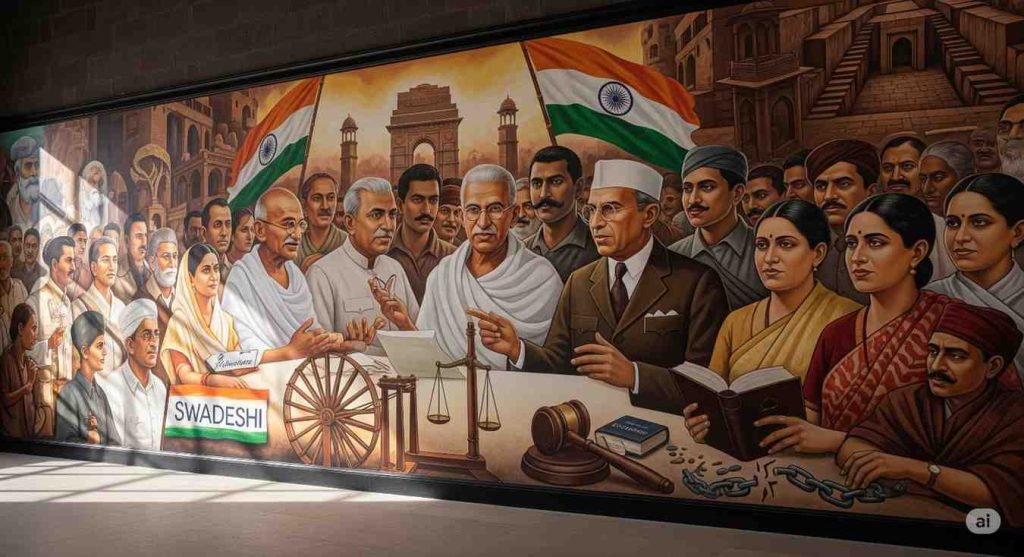
The late 19th century witnessed the rise of educated Indians who began questioning British rule through political channels. In 1885, the Indian National Congress (INC) was formed—a platform that would later lead the freedom movement.
Initially moderate in approach, INC leaders like Dadabhai Naoroji, Gopal Krishna Gokhale, and Bal Gangadhar Tilak laid the intellectual foundation for independence. They demanded greater representation, economic reforms, and civil rights.
But when peaceful petitions failed, the movement turned more assertive.
Revolutionaries and Martyrs
While many pursued non-violence, a powerful group of revolutionaries believed in armed resistance. They risked—and often gave—their lives to inspire the nation.
- Bhagat Singh, Rajguru, and Sukhdev became legends for their daring acts and ultimate sacrifice.
- Chandrashekhar Azad refused to be captured alive, dying with a bullet from his own gun.
- Masterda Surya Sen led the Chittagong Armoury Raid in Bengal.
Their actions weren’t just about revenge—they were messages to the youth that freedom was worth dying for.
Gandhiji and the Power of Non-Violence
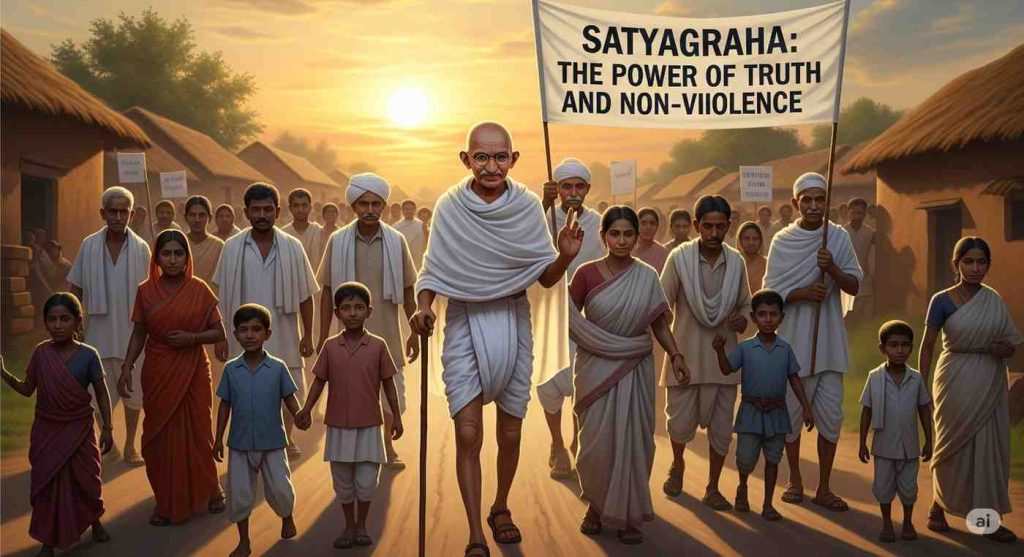
The true turning point in the Indian freedom struggle came in 1915, when Mahatma Gandhi returned from South Africa and introduced the philosophy of non-violent resistance.
Gandhiji led several mass movements:
- Non-Cooperation Movement (1920)
- Civil Disobedience Movement (1930), including the famous Dandi Salt March
- Quit India Movement (1942)
His principles of Satyagraha (truth-force) and Ahimsa (non-violence) transformed the struggle. Millions joined the movement—peasants, students, women, workers. The whole country was united in a peaceful rebellion.
World War II and the Final Push
During World War II, Britain used Indian resources and soldiers without consultation. This deepened resentment. Meanwhile, Indian leaders were imprisoned for launching the Quit India Movement, which boldly demanded: “British, Quit India!”
At the same time, Subhas Chandra Bose took a different path. Leading the Indian National Army (INA), he sought international support and inspired thousands to join the armed resistance under the slogan:
“Give me blood, and I will give you freedom.”
15th August 1947: The Dream Realised

After nearly 200 years of exploitation, sacrifice, and unbreakable will, India finally achieved independence on 15th August 1947. The British departed, and a free India emerged—though partition brought pain, displacement, and loss to millions.
Yet, amidst the tragedy, the nation stood proud. The tricolour was raised, and for the first time in centuries, Indians ruled themselves.
The Cost of Freedom
Freedom was not free. It came at the cost of:
- Millions of lives lost in revolts and partition
- Countless imprisonments and tortures
- Families torn apart
- Youth lost to martyrdom
Yet, the Indian freedom struggle continues to inspire movements for justice, dignity, and equality worldwide.
Unsung Heroes and Forgotten Voices
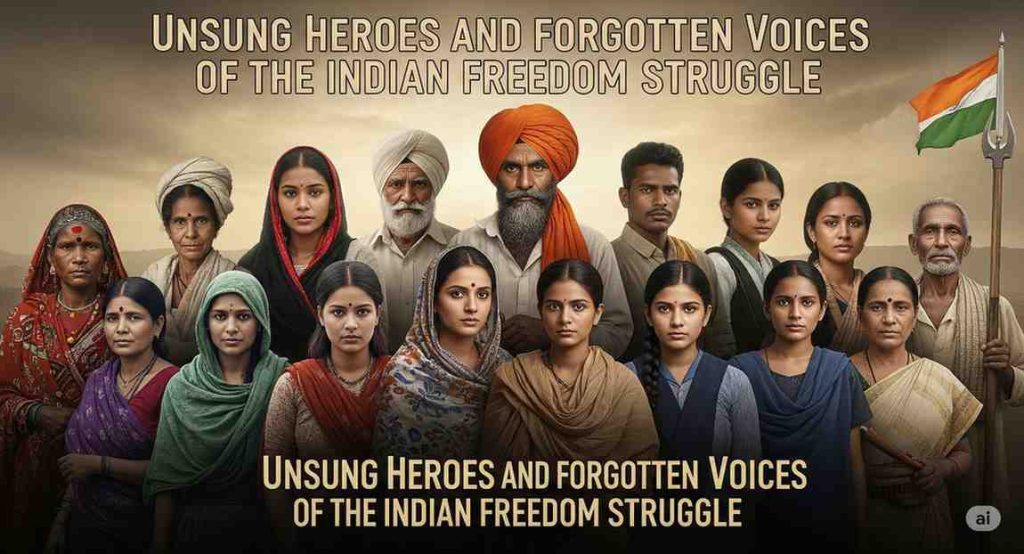
While names like Gandhi and Nehru are well known, India’s freedom was made possible by millions of nameless heroes:
- Village women who hid revolutionaries
- Farmers who refused to pay colonial taxes
- Writers and poets who kept the flame of nationalism alive
- Students who faced bullets to hoist the flag
Their stories remind us that freedom is not given—it is earned, every day, by brave souls who choose courage over fear.
FAQs on the Indian Freedom Struggle
1. What was the Indian freedom struggle?
The Indian freedom struggle was a long, historic movement aimed at ending British colonial rule in India. Spanning nearly 200 years, it included revolts, protests, and mass movements driven by a desire for justice, self-rule, and national dignity.
2. Who started the Indian freedom struggle?
The Indian freedom struggle began with early resistance against British control, but it formally gained momentum with the Revolt of 1857, considered the first war of independence. Key figures included Mangal Pandey, Rani Lakshmibai, and Bahadur Shah Zafar.
3. What were the main movements in the Indian freedom struggle?
Several powerful movements shaped the Indian freedom struggle, such as:
- Non-Cooperation Movement (1920)
- Civil Disobedience Movement (1930)
- Quit India Movement (1942)
- Armed resistance by revolutionaries like Bhagat Singh and the Indian National Army led by Subhas Chandra Bose.
4. What role did Mahatma Gandhi play in the Indian freedom struggle?
Mahatma Gandhi became the face of the Indian freedom struggle through his philosophy of non-violent resistance. His leadership transformed the movement into a nationwide campaign involving people from all sections of society.
5. When did the Indian freedom struggle end?
The Indian freedom struggle culminated on 15th August 1947, when India finally gained independence from British rule after nearly two centuries of resistance and sacrifice.
6. What was the cost of the Indian freedom struggle?
The Indian freedom struggle came at a huge cost—millions of lives lost, widespread suffering during Partition, and the relentless sacrifices of countless known and unknown patriots who fought for a free India.
7. Who were some unsung heroes of the Indian freedom struggle?
The Indian freedom struggle was supported by countless unsung heroes like:
- Matangini Hazra
- Alluri Sitarama Raju
- Aruna Asaf Ali
- Masterda Surya Sen
Their courage reminds us that freedom was won through collective effort, not just by a few well-known leaders.
Conclusion: A Legacy of Inspiration
The Indian freedom struggle is not just a chapter in history—it’s a living legacy. It teaches us the power of unity, sacrifice, and the indomitable human spirit. Today, as we enjoy the rights and opportunities that freedom brings, we must remember the responsibility it carries.
Let us not take our freedom for granted. Let us honour it—by building a more just, united, and empowered India. 🇮🇳 Jai Hind. Vande Mataram.
Know more related:
Competitive Exams After 10th for Career Growth
